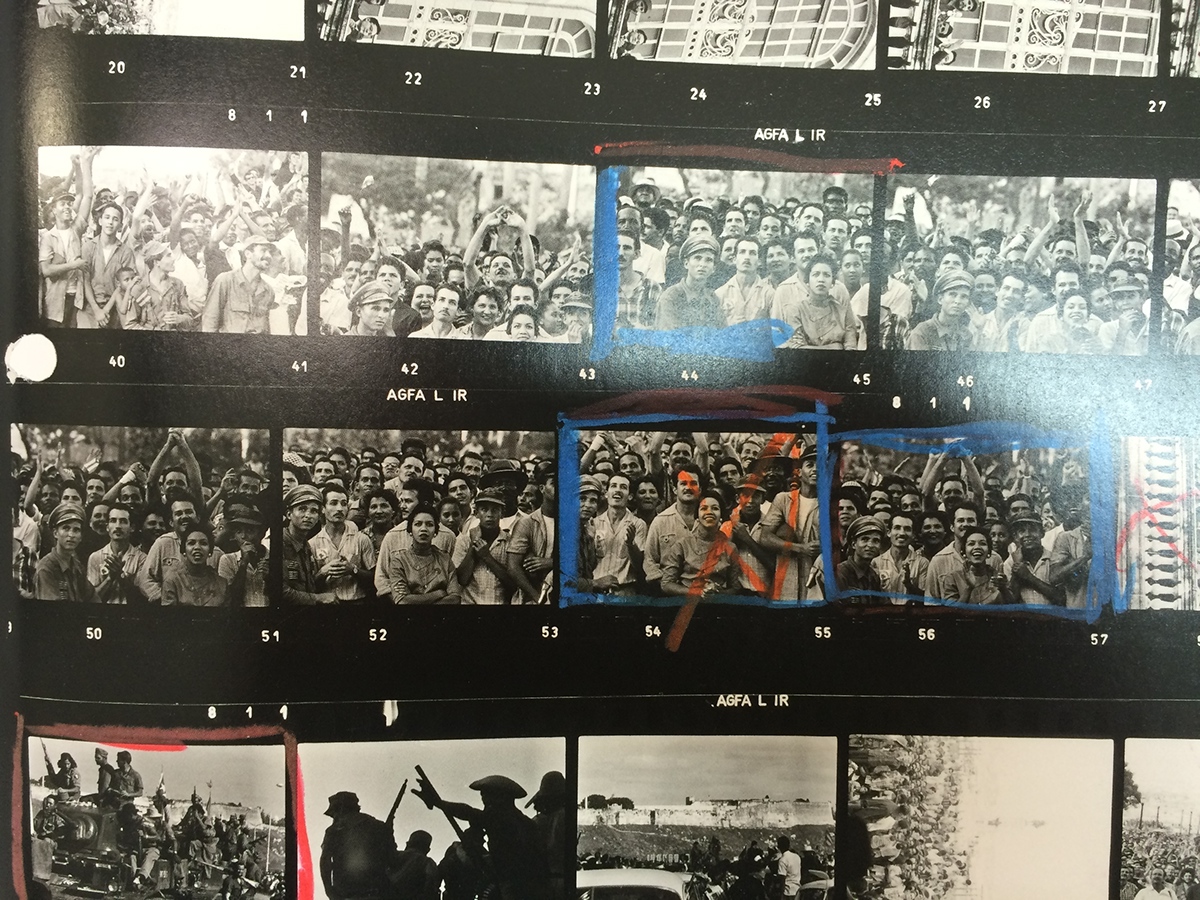Magnum Contacts Sheets
Edited by Kristen Lubben
I spent an hour or so flicking through the mass of varying documentary photography, I wanted to talk about the work that I found encapsulating, not just the contact sheets that show progression and development from the photographer. There were many well-created bodies of work and also sets of images where I felt the moment had been missed. It was both helpful and a hindrance to have the photographers markings on the contact sheets. Every time I agreed with the photographer’s choices but I found myself wanting to make that decision myself. The book shows a huge expanse of creativity allowing you to see the clarity of different styles between photographers.

Contact Sheet 1:
Burt Glinn – Havana Cuba
The first body of work that I picked was of Fidel Castrol from Burt Glinn. I chose his work because he demonstrated the use of patience and timing to freeze history and emotion. His contact sheet is in a muddled order but by looking at the exposure numbers you can see the sequence he has shot. He began by shooting a convoy of cars driving through the populated city streets, keeping everything in context by shooting wide and including the mountainous landscape in the background. Number six is the best composed as noticed and marked by Glinn. He then moves on to take tighter images of the soldiers riding on a tank; he try’s to capture their expressions and shoots portrait to keep some of the flagpoles in frame. I suspect he would have moved to a longer lens for this shots, but at the same time there is very little compression in the background. He may have waited for the tank to get closer to him before releasing the shutter. After a few more exposures he finds moves solely onto shooting the people and how they are reacting to what is happening. He begins by looking up and taking the people on a balcony, again trying to capture expressions and show the scale of what is happening. He plays with his composition encompassing the rule of thirds, revealing the scale of the building and finer details. After six or more images he feels as if he has tried his best to show that angle and moves on to where the images really step up.
As Robert Capa said 'If your pictures aren't good enough, you aren't close enough.' So this is what Glinn did, he started shooting the people in the crowds much closer; he got to the front and was in a lower position to get everybody looking up with them focusing their attention above him. I would assume the 35mm was reattached for these images, as he was able to include the people at the forefront as well as layers of faces and arms high in the air. Whilst in this position he was constantly making exposure and composition changes, which are visible from shot forty, to fifty-seven. Towards the end of the sequence he was nailing the exposures and achieving deep contrasts. This combined with the whites of the woman’s eyes, perfect teeth and an ecstatic crowd creates image number fifty-six.


Contact Sheet 2:
Eli Reed – Benaco Tanzania
The series named ‘Winter 1995’ by Eli Reed caught my attention as I have studied the Rwandan Genocide previously. Reed was lucky to get this assignment as Paul Fusco was set to cover it initially; thankfully she took his place and made a stunning job of it. She begins shooting strong images from the start, concentrating on portraits of the children. The first three exposures are primarily of one boy from three different angles; she adjusts herself but keeps the composition similar throughout. I could quite confidently say the whole set was shot with a 35mm from the distortion and how she positions subjects in the frame. She changes her shooting style in the from image four to eleven, she begins crouching down whilst looking up at her subjects. Getting close she fills the frame and uses negative space to isolate them from their surroundings. She knows she has a strong position here so continues to shoot multiple frames catching different expressions.
From then on her creativity just keeps expanding, she knows the impact of eye contact so it becomes more evident she is waiting for that moment. Midway through her film she begins shooting wider, allowing more room for the background to make an impersonation. All the time she is taking note of what is happening around her and quickly making decisions to shoot in different ways. She works well with negative space, when presented with a woman and child on the ground she stands up, points her camera down and waits for eye contact. Next she takes two images of what looks like a boy being measured, in the second shot she takes the background into account and includes a boy looking at her in the corner of the frame. This makes the photo even stronger as she is creating more of a story, especially as the child takes longer to notice in the shadows.
Personally I think the next seven shots of a child being weighed could have been taken differently. I would have isolated the child with a shallow depth of field, kept my camera in the landscape orientation and waited for the child to look at me. Nonetheless they are strong images and capture an emotive scene. My favourite image number thirty-three was taken in the last four frames. She has created a photo, which includes a strong subject at all three distances, whilst using the rule of thirds and gaining the perfect exposure. By picking her focus carefully she has chosen where your eye leads you, then to almost confuse you she positions another subject in the centre closer and out of focus. Precise, quick adjustments have been made to make this photo creatively powerful.




